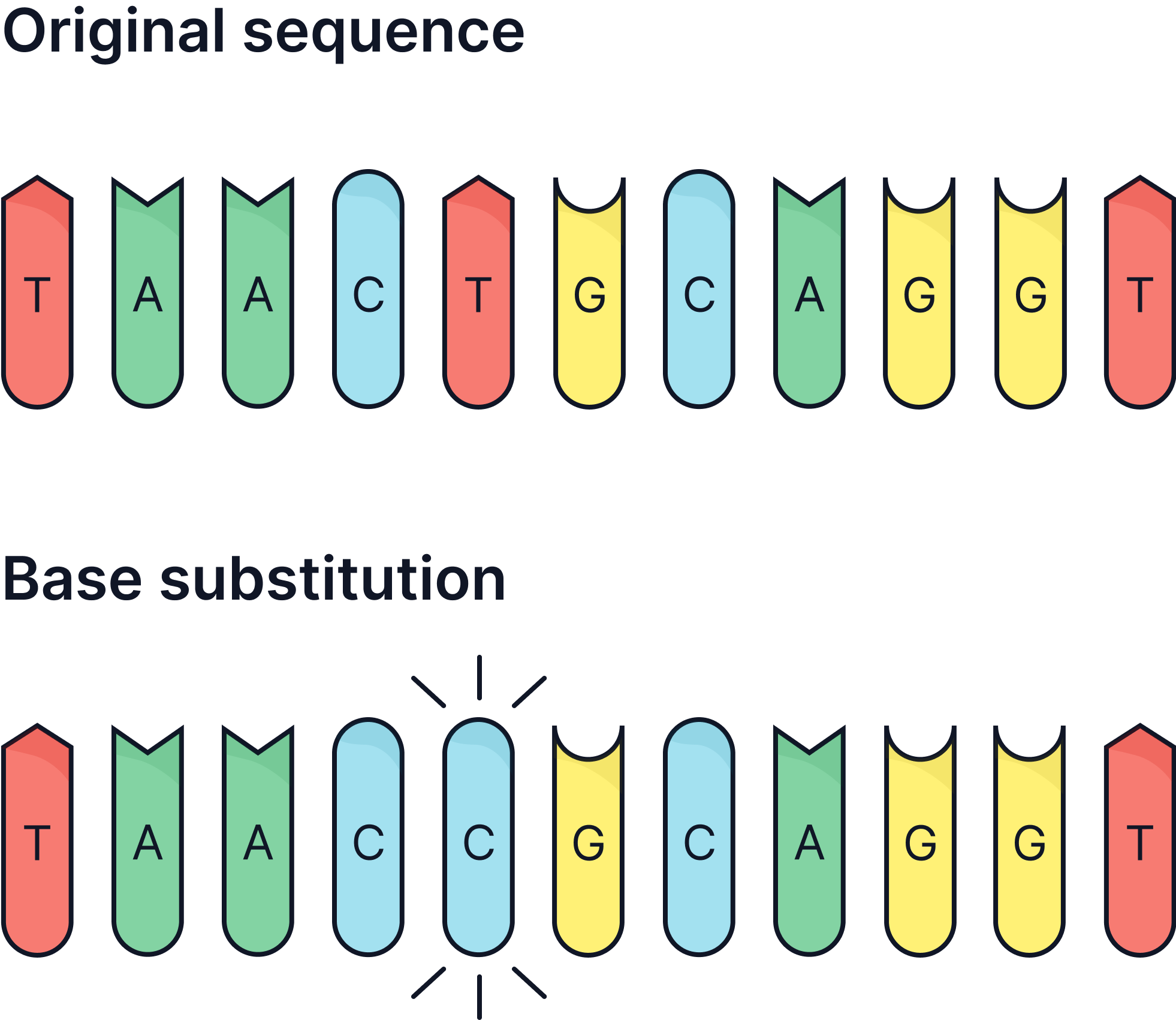Mutations
Laura Armstrong & Joe Wolfensohn
Teachers


Recall Questions
This topic requires prior knowledge of features of the genetic code and DNA structure. You can test your knowledge on these below.
The genetic code is degenerate, what does this mean?
More than one triplet / codon can code for the same amino acid.
What are the four bases found in DNA and how do they pair?
The four bases are adenine (A), thymine (T), cytosine (C), and guanine (G). A pairs with T, and C pairs with G.
What is a mutation?
A mutation is a change in the DNA base sequence of chromosomes. They can affect how a gene functions. Mutations can be beneficial, harmful, or have no effect.
Topic Explainer Videos
Check out this @JoeDoesBiology video that explains mutations or read the full notes below. Once you've gone through the whole note, try out the practice questions!
If you want another explainer of mutations, check out this video from @LauraDoesBiology and once you've gone through the whole note, try out the practice questions!
Mutations
What Are Mutations?
- Mutations are changes in the base sequence of DNA in chromosomes.
- They occur spontaneously during DNA replication but can also be caused by environmental factors.
- Some mutations result in a change in the amino acid sequence of a protein, potentially altering its function.
Types of Gene Mutations
Substitution Mutation

- A single nucleotide is swapped for another.
- Example: GAA - GTA (May result in a different amino acid being coded).
- Effects:
- Can be silent (no effect due to degeneracy of the genetic code and the same amino acid is still coded for).
- Can be missense (codes for a different amino acid, possibly altering protein function).
- Can be nonsense (introduces a premature stop codon, leading to a shorter and nonfunctional polypeptide).
Addition (Insertion) Mutation
- One or more extra nucleotides are inserted into the sequence.
- Effects:
- Can cause a frameshift mutation, altering every subsequent codon.
- This has the potential to alter all subsequent amino acids from the point of the mutation.
- This usually leads to a nonfunctional protein.
- Note: if three nucleotides, or any multiple of three nucleotides are added, this would not cause a frameshift.
Deletion Mutation
- One or more nucleotides are removed from the sequence.
- Effects:
- Also causes a frameshift mutation, altering every subsequent codon and potentially affecting all downstream amino acids.
- Typically results in a nonfunctional protein.
- Note: if three nucleotides, or any multiple of three nucleotides are deleted, this would not cause a frameshift.


Mutagenic Agents
- Certain factors increase the rate of mutations, known as mutagenic agents:
- Physical mutagens: UV radiation, X-rays.
- Chemical mutagens: Nitrous acid, benzene in cigarette smoke.
- Biological agents: Viruses such as human papilloma virus (HPV).
Potential Effects of Mutations
- Harmful: Can cause genetic disorders like cystic fibrosis if they result in a non- functional protein.
- Neutral: Silent mutations do not change the protein and so have no effect. This may be due to the degenerate nature of the genetic code. It may also be because the mutation occurred in an intron.
- Beneficial: Can lead to new alleles which give an advantage and increase survival chances, e.g., antibiotic resistance in bacteria.
Key Terms
- Mutation: A change in the DNA base sequence of a chromosome.
- Substitution: One nucleotide is swapped for another.
- Insertion: One or more nucleotides are added, possibly causing a frameshift.
- Deletion: One or more nucleotides are removed, possibly causing a frameshift.
- Frameshift: A shift in the reading frame due to an insertion or deletion, changing all subsequent triplets / codons.
- Mutagenic Agent: A factor that increases the rate of mutation.
- Intron: A non-coding section of DNA that does not code for amino acids in the final polypeptide.
Exam Tip
For questions on mutations they often provide you with a table, showing the mutations and the amino acids coded for. If so, make sure to use this information in your answer!
Explain how each mutation may affect the polypeptide for which this section of DNA is part of the code.
Mutation 1. (2 marks)
Mutation 2. (2 marks)
Mutation 1
no change to the sequence of amino acids
still codes for alanine / degenerate codon / same amino acid coded for
Mutation 2
change in the amino acid sequence as valine is replaced by alanine
the tertiary structure changes shape
Practice Question 1
Try to answer the practice question from the TikTok on your own, then watch the video to see how well you did!
Practice Question 2
If you want to try out another one, check this video out and see how you do!